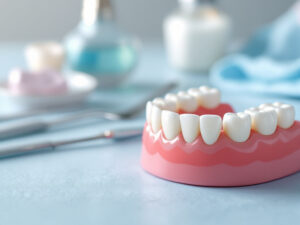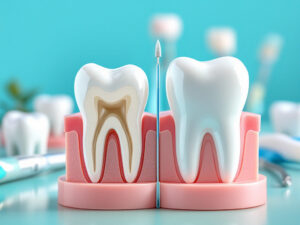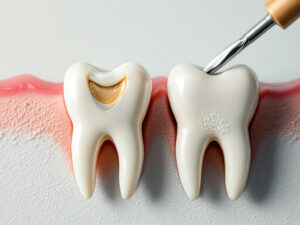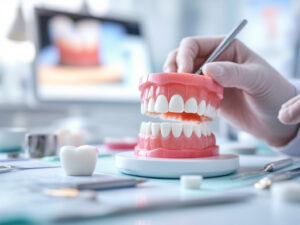Explore dental bridge placement
If you are missing one or more teeth, you may already know how it can affect your ability to speak, chew, and smile comfortably. Dental bridge placement is a time-tested option for replacing missing teeth, filling gaps in your smile, and restoring normal function. This approach involves anchoring an artificial tooth (pontic) to the adjacent natural teeth or dental implants, effectively bridging the empty space and providing a stable, supportive restoration.
A properly placed dental bridge can give you renewed confidence during social interactions and mealtimes, while also helping maintain overall oral health. When teeth are missing, neighboring teeth may gradually shift out of place, leading to alignment issues or occlusion problems. By opting for a dental bridge, you help prevent these potential complications. Moreover, the materials used in modern bridges, such as porcelain and ceramic, can blend beautifully with the rest of your teeth. These cosmetic benefits help create a genuine-looking smile in addition to preserving mouth functionality.
In many cases, this restorative treatment can be quicker and more affordable compared to dental implants, especially if your jawbone is not strong enough for implant placement. Though implants have their own set of advantages, a dental bridge can offer a comfortable alternative that still achieves phenomenal results. Before you decide on this route, it is helpful to explore the various bridge types, procedure timelines, and potential aftercare requirements.
Understand common bridge types
Many people assume there is only one kind of dental bridge, but you actually have multiple options to consider. Below are some of the most common types of dental bridges, each designed for different needs and circumstances.
Traditional or cantilever bridge
Traditional dental bridges involve placing crowns on two abutment teeth, one on either side of the gap. These abutment teeth are carefully reshaped to support the crowns, which together hold the pontic in place. Traditional bridges are frequently used when you have healthy teeth on both sides of the missing tooth or teeth. They are extremely durable and can handle significant biting pressure, making them a popular choice for missing teeth in the back of the mouth.
A cantilever bridge is similar in structure, except it is anchored to only one abutment tooth. This solution works well when you only have one tooth available for support. However, because a cantilever bridge puts extra stress on the single abutment tooth, it is often best for front teeth that do not experience the same level of chewing force as molars.
Maryland or resin-bonded bridge
Maryland bridges, also called resin-bonded bridges, are typically used to replace front teeth. In this design, a metal or porcelain framework is bonded to the back of the supporting teeth. This approach requires minimal alteration of adjacent teeth, preserving much of their natural structure. While Maryland bridges can be a more conservative option, they are less resistant to heavy biting pressure, so they are not ideal for large gaps or areas subject to strong chewing forces.
Implant-supported bridge
An implant-supported bridge is anchored by dental implants surgically placed in the jawbone. These small titanium or zirconia posts fuse with your bone over time, providing a stable foundation for a bridge that replaces multiple missing teeth. Implant-supported bridges can be an excellent choice if you have sufficient bone density, want long-lasting results, and prefer a permanent solution that does not rely on the support of natural teeth. Because the implants prevent bone loss in the jaw, this type of bridge typically delivers excellent stability and functionality. However, it does require extra time for surgery and healing.
Below is a quick comparison table:
| Bridge Type | Support Method | Ideal For | Considerations |
|---|---|---|---|
| Traditional/Cantilever | Crowns on 1-2 abutment teeth | One or two healthy adjacent teeth | Durable, but requires reshaping of abutment teeth |
| Maryland/Resin-bonded | Framework bonded to back of adjacent teeth | Replacing front teeth | Less invasive, but may be less durable in chewing areas |
| Implant-Supported | Posts surgically placed in jawbone | Multiple missing teeth, good bone density | Longer treatment timeline but highly stable |
Know the procedure timeline
The process of dental bridge placement typically requires at least two dental visits, though the exact number of appointments can vary based on the type of bridge you need. For a traditional or cantilever bridge, your first visit usually focuses on preparing the abutment teeth. If any tooth requires additional treatment, such as root canal therapy or a painless cavity filling, those procedures may take place before or during the initial appointment.
- Tooth preparation and impressions
- Your dentist shapes the abutment teeth to make room for crowns.
- Impressions are taken of your teeth and sent to a dental lab to create a custom-fitted bridge.
- Usually, you are provided a temporary bridge to protect your prepared teeth while the permanent one is fabricated.
- Final fitting and cementation
- During your second appointment, your new bridge is carefully checked for comfort, fit, and color match.
- Adjustments are sometimes made to ensure proper bite, and then the bridge is permanently cemented into place.
Some patients might also benefit from advanced diagnostics, such as 3d imaging dental diagnostics or intraoral camera examination, to ensure highly accurate impressions and evaluations. If you opt for an implant-supported bridge, expect a longer treatment timeline, since implants must first integrate with your jawbone. This process can take several months and may involve more than two office visits.
Taking the time to complete each step thoroughly helps ensure the success and longevity of your restoration. By waiting for the bridge or implant to integrate properly, you can expect superior functionality, comfort, and confidence in your new smile.
Avoid complications
Like all dental procedures, dental bridge placement can present potential issues if not well maintained. Some individuals experience tooth sensitivity or gum irritation near the abutment teeth, especially during the first few weeks. Others may notice slight discomfort if the bridge requires minor adjustments to achieve proper bite alignment. While these typically subside with time, it is best to stay proactive and reach out to your dentist if you notice any of the following:
- Persistent pain or unusual tenderness around the abutment teeth
- Swelling or gum inflammation that does not improve
- Ongoing sensitivity to extreme temperatures
- Difficulty biting, chewing, or speaking long after the placement
In many cases, routine preventive measures such as professional teeth cleaning and routine dental checkup will help keep your new bridge in optimal condition. Good oral hygiene goes beyond basic brushing and flossing. It includes flossing underneath the bridge with special threaders or interdental brushes, limiting sugary diets, and promptly addressing any early signs of complications.
Occasionally, a dental bridge can become loose or damaged due to biting hard objects or grinding your teeth. Using a mouthguard if you clench or grind, or wearing a protective guard during contact sports, significantly reduces this risk. Additionally, maintaining your gum health through gum disease treatment is vital because strong, healthy gums form the foundation for any long-lasting restoration.
Compare with implants
If you are researching tooth replacement options, you have likely come across both dental bridges and implants. Understanding the main differences can help you make an informed decision:
- Bone preservation: Implants fuse with your jawbone and help preserve bone structure, while dental bridges rely on neighboring teeth for support.
- Treatment timeline: A dental bridge can usually be completed in weeks, whereas implants often require multiple months to fully integrate, including surgery and healing time.
- Cost considerations: Traditional bridges may be more budget-friendly initially, but implants can sometimes offer better long-term value if you are mindful of bone preservation and anticipate the longevity of your new teeth.
- Maintenance: Both bridges and implants require diligent hygiene routines. However, implants typically need less specialized flossing since their design mimics natural tooth roots and does not rely on pontics resting against the gums.
Ultimately, the choice depends on your oral health status, personal preferences, and overall goals. During a private dental consultation, a board-certified dentist can thoroughly evaluate your bone density, gum condition, and bite alignment to help you decide between a dental bridge or an implant-based alternative. Dentistry is rarely one-size-fits-all, and your comfort and satisfaction remain top priorities.
Proper aftercare guidelines
A vital part of ensuring your dental bridge remains comfortable and functional is committing to proper aftercare. You typically need one to two weeks for your mouth to adapt to the new bridge, though you may feel normal sooner or slightly longer, depending on your oral health and sensitivity.
Consider these tips for a smooth transition:
- Watch your diet
- Try to avoid sticky or very hard foods, especially in the early days following your procedure.
- Cutting your food into smaller pieces makes chewing more manageable until you feel fully adjusted.
- Handle sensitivity
- Mild tenderness or sensitivity to hot and cold foods might occur initially.
- Rinsing gently with warm salt water can soothe the gums, while toothpaste designed for sensitive teeth can help limit discomfort.
- Clean thoroughly
- Brush at least twice a day with fluoride toothpaste, and floss daily.
- Use specialized floss threaders or interdental brushes to clean under the pontic and around abutment teeth.
- If you have concerns about technique, don’t hesitate to ask your dental team during a new patient dental exam or your next checkup.
- Stay consistent with follow-ups
- Scheduling regular evaluations helps ensure the long-term success of your bridge.
- If you detect any sign of looseness or need an adjustment, prompt attention from a dental professional can spare you from more extensive repairs down the line.
Making these habits part of your daily routine not only protects your restoration but also contributes to the overall health of your existing natural teeth.
Why choose Cloninger Dentistry
When you decide to pursue dental bridge placement, you want to partner with a provider that offers not just expertise, but also a caring and supportive environment. At Cloninger Dentistry, you are at the center of everything we do. We understand unique challenges in oral health, and we are committed to delivering the support necessary for lasting results:
- Comprehensive care: We offer a wide range of [family dental care] and preventative services to ensure your teeth, gums, and restorations remain in excellent condition. From professional teeth cleaning to gum disease treatment, we work with you to keep your mouth healthy at every stage of life.
- State-of-the-art technology: Cloninger Dentistry employs modern tools, including digital xray imaging and advanced drafting software, so that each bridge is designed with accuracy and long-lasting performance in mind.
- Compassionate approach: Our team takes pride in a supportive atmosphere that allows you to feel comfortable asking questions and expressing any concerns.
- Transparent pricing: We are an insurance friendly dental practice offering a written treatment estimate before we begin, ensuring you understand the costs associated with your care. If financing is a concern, flexible financing dental solutions are also available.
- Personalized guidance: Your lifestyle, oral health history, and treatment goals guide our decisions. We will help you weigh the pros and cons of a bridge versus other solutions, always keeping your long-term wellbeing in mind.
At Cloninger Dentistry, you will find a knowledgeable team that strives to provide a comfortable experience from start to finish. If you are ready to restore your smile and function through a dental bridge, we are here to walk with you at every step.
Frequently asked questions
How long does a dental bridge last?
With proper care, a dental bridge can often last five to 15 years, and some even exceed that range. Lifespan depends on factors such as bridge material, your oral hygiene routine, and regular checkups. Visiting your dentist at least twice a year for professional cleanings and evaluations can help identify wear or damage early.
Does dental bridge placement hurt?
You typically experience only mild discomfort during the procedure. Local anesthesia helps numb the area while your teeth are prepared for the crowns. Some patients report minor sensitivity in the days following bridge placement, which subsides in a short time. Should you feel lingering pain, schedule an appointment to ensure everything is healing properly.
Do I need special cleaning tools for my bridge?
Yes. Although you should continue normal brushing and flossing, it is important to add special floss threaders or interdental brushes to your routine. These tools help remove food particles trapped beneath the bridge. If you are unsure how to use them, your dental hygienist can provide a quick demonstration.
Will my bridge look natural?
Modern materials include porcelain and ceramic, which can be closely matched to the shape and color of your natural teeth. High-quality bridges typically blend seamlessly, so it is not evident that you have a prosthetic piece. This natural appearance can boost confidence and enhance the aesthetics of your smile.
Is a dental bridge more affordable than an implant?
Typically, a traditional or cantilever bridge can be more cost-effective initially compared to an implant-based restoration. However, in the long run, implants might be more cost efficient if you are concerned about bone preservation and long-term outcomes. The decision often depends on your oral health needs, personal preferences, and budget. Consulting closely with your dental team will help you decide which option truly suits you.
By learning about dental bridge placement, understanding how to care for your restoration, and deciding where to receive treatment, you can make confident choices about your oral health. Replacing missing teeth can help you regain the joy of sharing a smile, speaking clearly, and savoring your favorite meals without worry. If you ever have concerns about your oral health or want to explore additional treatments such as dental crown placement or tooth extraction service for compromised teeth, Cloninger Dentistry is ready to provide you with the support and understanding you deserve on your path to a healthier, complete smile.










